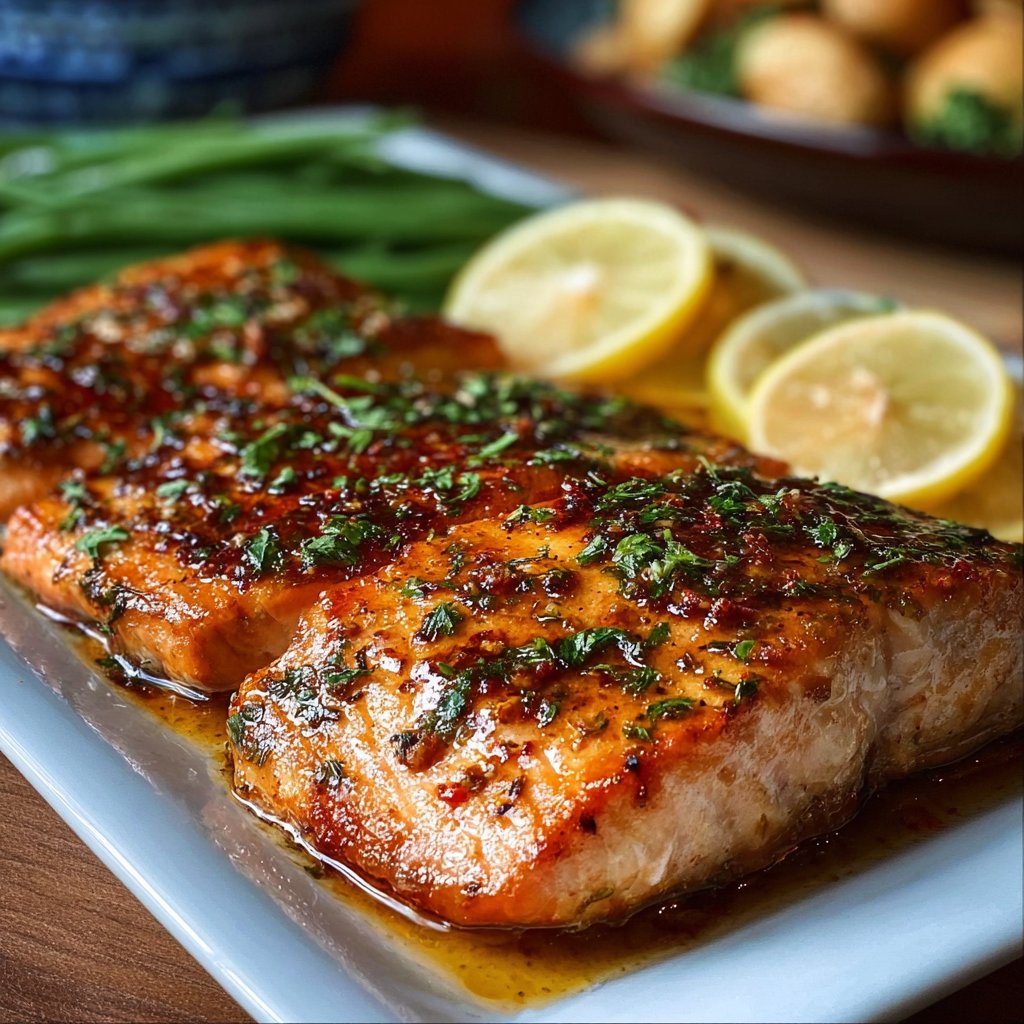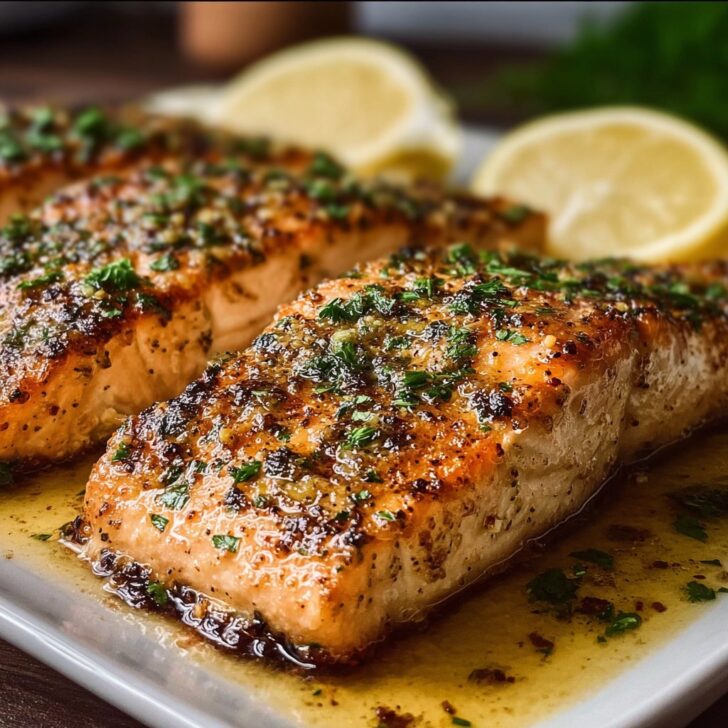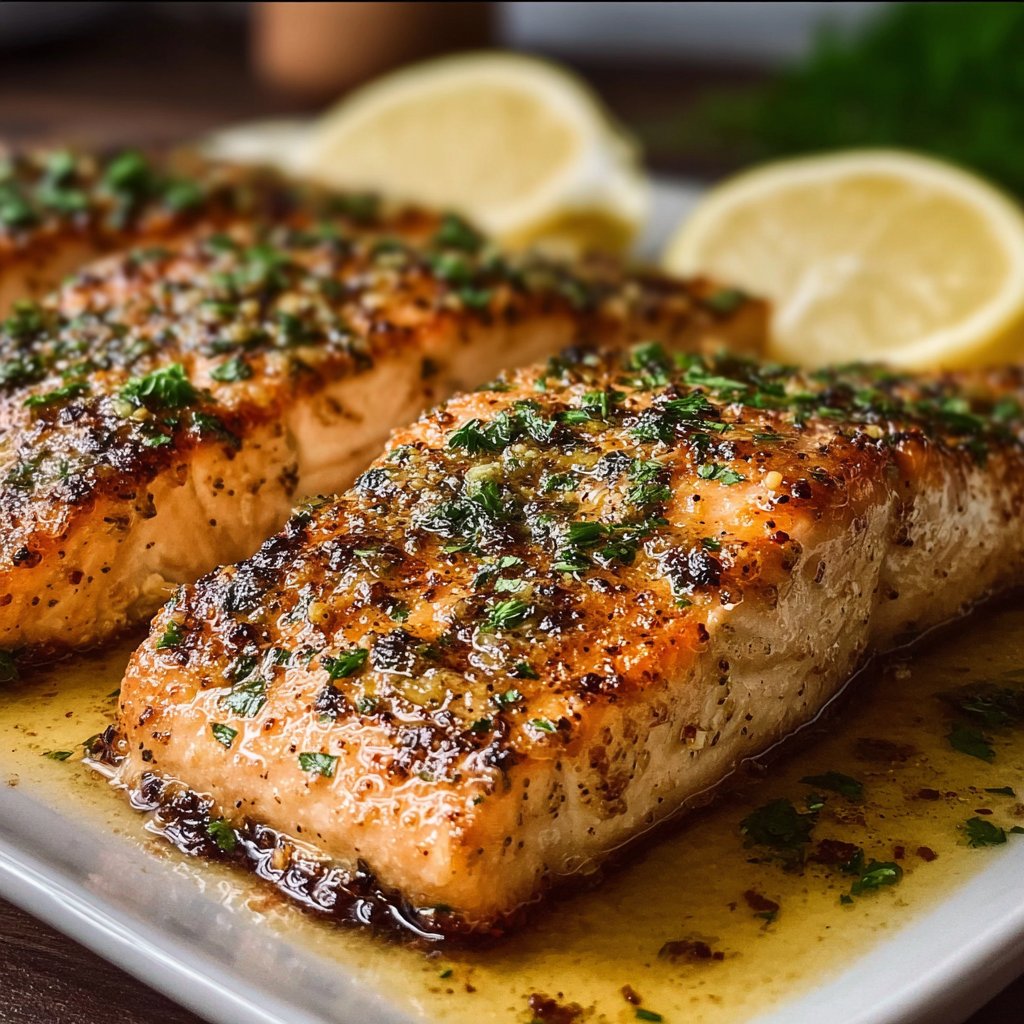Hey y’all! If you’ve been craving that buttery, garlicky, steakhouse-style salmon at home, this Texas Roadhouse-Style Baked Salmon nails the juicy texture and bold flavor—without the fuss. It’s quick enough for a weeknight and special enough for guests, complete with a caramelized glaze and fresh lemon finish. Let’s get cooking!
- Prep Time: 10 minutes
- Cook Time: 12–15 minutes
- Total Time: 25 minutes
- Yield: Serves 4
- Oven Temp: 400°F (204°C)
Why You’ll Love This Texas Roadhouse-Style Baked Salmon
- Big steakhouse flavor with a glossy, garlicky-butter glaze and a hint of sweet heat.
- Fast and foolproof—on the table in under 30 minutes, start to finish.
- Restaurant-quality texture: flaky, moist, and lightly caramelized at the edges.
- Simple pantry ingredients you probably already have.
- Versatile for weeknights, meal prep, or a date-night dinner.
Ingredients for Texas Roadhouse-Style Baked Salmon
- 4 salmon fillets (skin-on), 6 oz/170 g each (about 1.5 lb/680 g total)
- 1 tablespoon light brown sugar, packed
- 1 ¼ teaspoon kosher salt, divided
- ½ teaspoon freshly ground black pepper
- 1 teaspoon paprika
- ½ teaspoon smoked paprika
- ½ teaspoon garlic powder
- ¼ teaspoon onion powder
- ⅛ teaspoon cayenne pepper (optional, for mild heat)
- 2 tablespoon unsalted butter, melted
- 1 tablespoon extra-virgin olive oil
- 1 tablespoon fresh lemon juice (about ½ lemon)
- 1 teaspoon lemon zest
- 2 teaspoon finely chopped fresh parsley, plus more for garnish
- Lemon wedges, for serving
Directions: Step-by-Step
1) Preheat and Prepare the Pan
Preheat oven to 400°F (204°C). Line a rimmed baking sheet with foil or parchment for easy cleanup and lightly brush with olive oil.
2) Mix a Buttery Texas-Style Glaze
In a small bowl, whisk together melted butter, olive oil, brown sugar, ¼ teaspoon kosher salt, black pepper, paprika, smoked paprika, garlic powder, onion powder, cayenne (if using), lemon juice, lemon zest, and parsley.
3) Season the Salmon
Pat salmon dry thoroughly with paper towels (key for browning). Sprinkle the flesh side evenly with the remaining 1 teaspoon kosher salt. Place fillets skin-side down on the sheet.
4) Bake the Salmon to Juicy Perfection
Spoon or brush about two-thirds of the glaze over the salmon. Bake for 10–12 minutes, until the thickest part registers 120–125°F (49–52°C) for medium. For well-done, go to 130–135°F (54–57°C); the USDA recommends 145°F/63°C for safety.
5) Broil for a Caramelized Finish
Switch the oven to broil. Brush on the remaining glaze and broil 1–2 minutes, watching closely, until lightly blistered and glossy.

6) Rest, Garnish, and Serve
Let rest 3 minutes to reabsorb juices. Shower with extra parsley and serve with lemon wedges for a bright, zesty pop.
Notes for Texas Roadhouse-Style Baked Salmon
- Pin bones happen! Run fingers along the fillets and pull any bones with clean tweezers—here’s a quick guide: How to remove pin bones.
- For even cooking, let salmon sit at room temperature 10–15 minutes while the oven heats.
- Use an instant-read thermometer so you nail your ideal doneness every time.
Variations: Make It Your Way
- Lemon Pepper & Herb: Swap smoked paprika for 1 teaspoon lemon pepper seasoning; add 1 tablespoon chopped dill.
- Cajun Honey Butter: Replace paprika mix with 1–1 ½ teaspoon Cajun seasoning; swap brown sugar for 1 tablespoon honey.
- Maple-Dijon & Pecan: Stir 1 tablespoon Dijon and 1 tablespoon maple syrup into the butter; top with 2 tablespoon chopped toasted pecans after baking.
Equipment You’ll Need
- Rimmed baking sheet + foil or parchment
- Small mixing bowl and whisk
- Measuring cups/spoons
- Microplane or zester
- Silicone brush or spoon for glazing
- Instant-read thermometer
- Fish spatula
- Kitchen tweezers (for pin bones)
Storage & Reheating
- Fridge: Store cooled salmon in an airtight container up to 3–4 days.
- Freezer: Wrap tightly and freeze up to 2 months; thaw overnight in the fridge.
- Reheat: For best texture, warm at 275°F (135°C) for 10–12 minutes or gently in a covered skillet over low heat with a splash of water.
Serving & Pairings with Texas Roadhouse-Style Baked Salmon
- Classic sides: Baked potato with butter, roasted asparagus, buttered corn, or garlic mashed potatoes.
- Fresh plates: House salad with ranch, chopped salad, or a peppery arugula mix with lemon vinaigrette.
- Grains: Herbed rice pilaf, quinoa, or garlicky couscous.
- Beverages: Crisp Chardonnay, Sauvignon Blanc, or a citrusy IPA.
Pro Tips for Texas Roadhouse-Style Baked Salmon
- Dry the surface well: Moisture prevents browning—pat the fish dry right before seasoning for a better crust.
- Season smart: Lightly salting 10–15 minutes ahead helps the salt dissolve and season deeper; learn more in this salmon guide: How to cook salmon like a pro.
- Don’t skip the rest: A brief 3-minute rest after baking keeps juices in the fillet for extra succulence.
FAQ: Texas Roadhouse-Style Baked Salmon
Can I use skinless salmon? Yes—reduce bake time by about 1 minute and grease the parchment well so it doesn’t stick.
What if my fillets are different sizes? Start checking the thinner pieces at 8–9 minutes and pull them early; leave thicker ones in until they hit your target temp.
Can I make this dairy-free? Absolutely—swap butter for a quality plant-based butter or use all olive oil (the glaze will be slightly less rich).
Ingredients
- 4 salmon fillets (6–8 oz each), skin on or off as preferred
- 2 tablespoons olive oil
- 3 tablespoons unsalted butter, melted
- 2 tablespoons brown sugar
- 2 cloves garlic, minced
- 1 tablespoon fresh lemon juice
- 1 teaspoon paprika
- 1/2 teaspoon salt
- 1/4 teaspoon black pepper
- 2 tablespoons chopped fresh parsley (optional, for garnish)
Instructions
-
1Preheat the oven to 400°F (204°C). Line a baking sheet with parchment paper or lightly grease with oil.
-
2Pat salmon fillets dry with paper towels and place them skin-side down (if skin-on) on the prepared baking sheet. Brush each fillet with olive oil and season lightly with salt, pepper, and paprika.
-
3In a small bowl, whisk together melted butter, brown sugar, minced garlic, and lemon juice until smooth and combined.
-
4Brush the butter-brown sugar mixture evenly over the tops of the salmon fillets, reserving a little for finishing if desired.
-
5Bake the salmon in the preheated oven for about 12–15 minutes, or until the fish is opaque and flakes easily with a fork. Cooking time will vary slightly by fillet thickness.
-
6Remove from oven, spoon any pan juices over the fillets, garnish with chopped parsley, and serve immediately with lemon wedges on the side.
Approximate Information for One Serving
Nutrition Disclaimers
Number of total servings shown is approximate. Actual number of servings will depend on your preferred portion sizes.
Nutritional values shown are general guidelines and reflect information for 1 serving using the ingredients listed, not including any optional ingredients. Actual macros may vary slightly depending on specific brands and types of ingredients used.
To determine the weight of one serving, prepare the recipe as instructed. Weigh the finished recipe, then divide the weight of the finished recipe (not including the weight of the container the food is in) by the desired number of servings. Result will be the weight of one serving.
Did you make this recipe?
Please consider Pinning it!!


